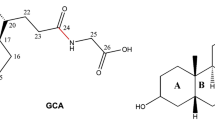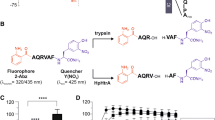Abstract
Bile acids deactivate certain enzymes, such as prolyl endopeptidases (PEPs), which are investigated as candidates for protease-based therapy for celiac sprue. Deactivation by bile acids presents a problem for therapeutic enzymes targetted to function in the upper intestine. However, enzyme deactivation by bile acids is not a general phenomenon. Trypsin and chymotrypsin are not deactivated by bile acids. In fact, these pancreatic enzymes are more efficient at cleaving large dietary substrates in the presence of bile acids. We targeted the origin of the apparently different effect of bile acids on prolyl endopeptidases and pancreatic enzymes by examining the effect of bile acids on the kinetics of cleavage of small substrates, and by determining the effect of bile acids on the thermodynamic stabilities of these enzymes. Physiological amounts (5 mM) of cholic acid decrease the thermodynamic stability of Flavobacterium meningosepticum PEP from 18.5 ± 2 kcal/mol to 10.5 ± 1 kcal/mol, while thermostability of trypsin and chymotrypsin is unchanged. Trypsin and chymotrypsin activation by bile and PEP deactivation can both be explained in terms of a common mechanism: bile acid-mediated protein destabilization. Bile acids, usually considered non-denaturing surfactants, in this case act as a destabilizing agent on PEP thus deactivating the enzyme. However, this level of global thermodynamic destabilization does not account for a more than 50% decrease in enzyme activity, suggesting that bile acids most likely modulate enzyme activity through specific local interactions.


Similar content being viewed by others
Abbreviations
- PEP:
-
Prolyl endopeptidase
- FM:
-
Flavobacterium meningosepticum
- SC:
-
Sphingomonas capuslata)
References
Ehren J, Govindarajan S, Moron B, Minshull J, Khosla C (2008) Protein Eng Des Sel 21(12):699–707
Feitosa E, Brown W, Hansson P (1996) Macromolecules 29(6):2169–2178
Gass J, Khosla C (2007) Cell Mol Life Sci 64(3):345–355
Gass J, Vora H, Hofmann AF, Gray GM, Khosla C (2007) Gastroenterology 133(1):16–23
Gass J, Khosla C (2006) Cell Mol Life Sci 64(3):345–355
Gass J, Ehren J, Strohmeier G, Isaacs I, Khosla C (2005) Biotechnol Bioeng 92(6):674–684
Ghosh S, Banerjee A (2002) Biomacromolecules 3(1):9–16
Gudiksen KL, Gitlin I, Moustakas DT, Whitesides GM (2006) Biophys J 91(1):298–310
Hjelmeland LM (1980) Proc Natl Acad Sci USA 77(11):6368–6370
Hoffman AF (1994) Intestinal absorption of bile acids and biliary constituents: the intestinal component of the enterohepatic circulation and the integrated system. In: Johnson LR, Alpers DH, Christensen J, Jacobson ED, Walsh JH (eds) Physiology of the gastrointestinal tract, 3rd edn, vol 2. Rave Press, New York, NY, pp 1845–1865
Hofmann AF (2009) Hepatology 49(5):1403–1418
Hofmann AF, Eckmann L (2006) Proc Natl Acad Sci USA 103(12):4333–4334
Jones MN (1992) Chem Soc Rev 21:127–136
Kagnoff MF (2007) J Clin Invest 117(1):41–49
Kasserra HP, Laidler KJ (1969) Can J Chem 47(21):4021–4029
Mukhopadhyay S, Maitra U (2004) Curr Sci 87(12):1666–1683
Myers JK, Pace CN, Scholtz JM (1995) Protein Sci 4(10):2138–2148
Otzen DE, Christiansen L, Schulein M (1999) Protein Sci 8(9):1878–1887
Porcel EM, Foose LL, Svitova TF, Blanch HW, Prausnitz JM, Radke CJ (2009) Biotechnol Bioeng 102(5):1330–1341
Santoro MM, Bolen DW (1992) Biochemistry 31(20):4901–4907
Shan L, Marti T, Sollid LM, Gray GM, Khosla C (2004) Biochem J 383(Pt 2):311–318
Siegel M, Bethune MT, Gass J, Ehren J, Xia J, Johannsen A, Stuge TB, Gray GM, Lee PP, Khosla C (2006) Chem Biol 13(6):649–658
Simonović BR, Momirović M (1997) Microchimica Acta 127(1):101–104
Sollid LM, Khosla C (2005) Nat Clin Pract Gastroenterol Hepatol 2(3):140–147
Tan EH, Birge RR (1996) Biophys J 70(5):2385–2395
Tofani L, Feis A, Snoke RE, Berti D, Baglioni P, Smulevich G (2004) Biophys J 87(2):1186–1195
Wainfan E, Hess GP (1960) J Am Chem Soc 82(8):2069–2073
Walsh KA (1970) Trypsinogens and trypsins of various species. In: Lorand L, Perlmann GE (eds) Methods in enzymology; proteolytic enzymes, vol 19. Academic Press, New York, pp 41–63
Warren JR, Gordon JA (1971) Biochimica et Biophysica Acta (BBA)—Protein Struct 229(1):216–225
Acknowledgments
We thank Chaitan Khosla for providing us with plasmids encoding FM and SC PEP, Ruth Riter (Agnes Scott College, Department of Chemistry) for allowing us to use the fluorimeter, and Giulietta Spudich and Chiwook Park for critical reading of the manuscript.
Author information
Authors and Affiliations
Corresponding author
Rights and permissions
About this article
Cite this article
Robic, S., Linscott, K.B., Aseem, M. et al. Bile Acids as Modulators of Enzyme Activity and Stability. Protein J 30, 539–545 (2011). https://doi.org/10.1007/s10930-011-9360-y
Published:
Issue Date:
DOI: https://doi.org/10.1007/s10930-011-9360-y




